|
Highlights
Overview of news
and events
RegioTram
Groningen
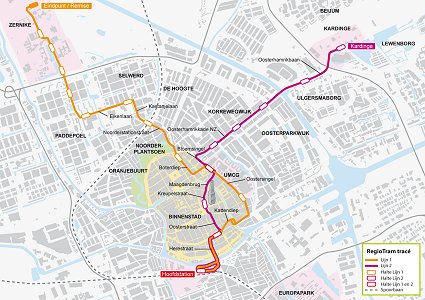
Map:
(C) Project office RegioTram, september 2010
Groningen
(Netherlands) decided to introduce a tram. The proposed system entails
two lines (2016) and regional 'tram-train' extensions (after 2020).
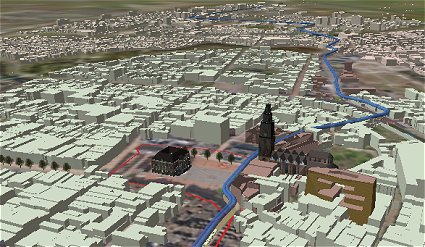
Image
courtesey www.3d.groningen.nl, February
2009
RandstadRail Dutch showcase light rail
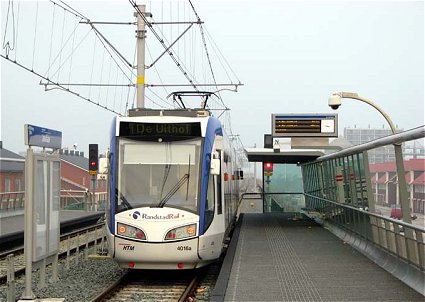
RR-3
& RR-4 backbone of RandstadRail The Hague region
Photo: (C) Light Rail Atlas/Kees Pronk,
Zoetermeer, January 1, 2008
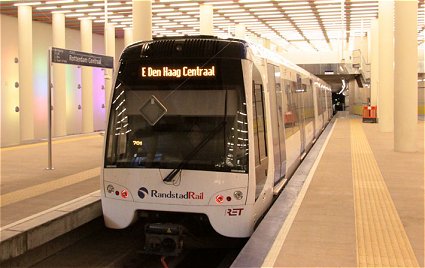
RR-E
backbone of RandstadRail Rotterdam region
Photo: (C) Light Rail Atlas/Kees Pronk,
Rotterdam, August 21, 2010
RandstadRail
is another important light rail project in The Netherlands. Since
2011 fully operational.
New
definition of light rail
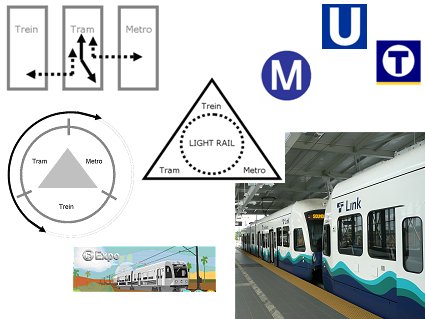
Image:
(C) RVDB/Lightrail.nl (Rob van der Bijl)
Amsterdam October 2009
Light rail represents operation on one or more types of rail infrastructure.
Lightrail.nl
compiled a new definition of light rail, in colaboration with ProRail,
the Dutch national railinfrastructure provider (2009-2010).
Definition: 'Light rail is a rail-bound mode of public transport for
cities and urban regions. Contrary to train (heavy rail) and metro (subway,
underground) light rail principally is able to be integrated within
public realm, sharing public space with other traffic to some extend.'
Source: RVDB/Lightrail.nl, February 19, 2010, Amsterdam, Netherlands.
Lightrail.nl
presents a 'vintage' page
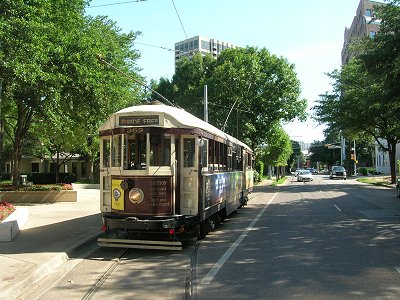
Example:
Dallas (Texas, USA). The McKinney Avenue Transit Authority maintains,
restores and preserves historic trolley cars while educating the public
on the role they played in the development of Dallas. The vintage line
provides a touristic oriented public transport service within Uptown
and Downtown. Photo by Rob van der Bijl, Dallas, Texas, June 7, 2007.
Lightrail.nl
investigates the meaning of vintage tramway and light rail projects.
The first case study is the 'Electric Tramway' ('Elektriske Sporvei')
of Bergen (Norway). This city hosts a magnificent vintage tramway project.
Construction and planning are well under way. Meanwhile a first portion
of the line is in operation.De eerste case studie is de 'Elektrische
Tram' ('Elektriske Sporvei') van Bergen (Noorwegen). Click here...
Light
Rail Portland (OR) expanding
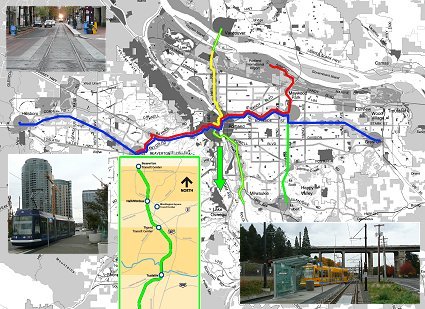
Photos
& map: (C) Light Rail
Atlas/Rob van der Bijl
Portland, Oregon, November 2, 2008
The three existing lines in blue, red and yellow. Extensions in green-yellow.
WES see box. Streetcar to Lake Oswego in direction of green arrow.
New city loop of Streetcar not on the map..
The
light rail system of Portland will expand substantially and support
future urban development. A new light rail line along I-205 will serve
Clackamas County, Milwaukie and Southeast Portland in 2009. In down
town a new alignment will be served too, called 'Portland mall'. Eventually
this line will be used for future extensions, e.g. to Milwaukie in 2015.
WES, the first commuter rail line in Oregon opens February 2, 2009.
Self-propelled diesel trains will carry passengers between Beaverton,
Tigard, Tualatin and Wilsonville. Streetcar will expand too. A new loop
across the river has been envisaged, while an extension to Lake Oswego
is under investigation.
Toyama Case Study
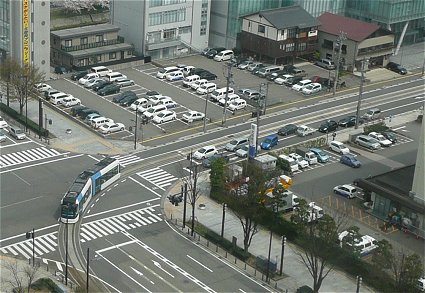
Photo:
(C) Light Rail Atlas/Rob van der Bijl, Toyama, April 7, 2008
Aerial view of the street section of the new line to the harbor (PORTRAM).
Toyama is Japan's showcase light rail project. And case study of Lightrail.nl/.
The city of Toyama (Japan) took an important leap to redevelop the economic
potential of down town by opening of a 3.5km tramway loop (December,
23, 2009). The single track loop comprises a new section of 0.9km that
serves as a short cut between the two legs of the existing urban system.
The loop is operated with three new trams, named 'Centram', which are
similar to the cars that operates 'Portram', the converted harbour line
(see earlier news).
See Lightrail.nl's case study at: www.lightrail.nl/toyama - click here...
International
tramway between Hasselt (BE) and Maastricht (NL)

Hasselt-Maastricht
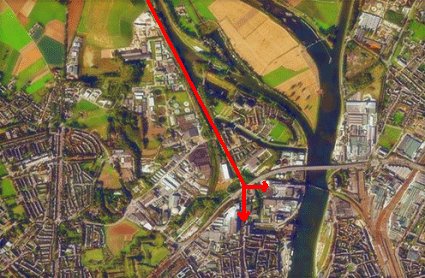
Image:
(C) Light Rail Atlas, Route north of Maastricht.
The Flamish government has approved the proposal to connect the
city of Hasselt (BE) to Maastricht (NL) by means of a new regional tramway.
The tram will use new street sections in Hasselt and existing and former
railway for the remaining portion to Maastricht. Due to open in 2016.
New tramway of Nice serves as an 'open air art museum'
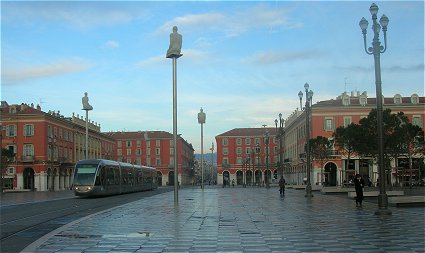
Photo:
(C) Light Rail Atlas/Rob van der Bijl, Nice, February 1, 2008
The new tramway of Nice (France) opened on November 25th 2007. Along
with the new line the local authorities have taken the chance to completely
regenerate the downtown area of Nice. It has a new spectacular pedestrian
piazza in the form of place Massena, tree lined streets and car free
zones. It's not an over statement to say that the trams of Nice serve
an 'open air art museum', as the regenerated public realm has been enhanced
with 15 art projects like the one of Jaume Plensa at the place Masséna:
'Conversation with Nice', a master work of art that comprises of seven
illuminated sculptures representing the dialogue with seven continents
(see photo).
Light rail Zwolle-Kampen
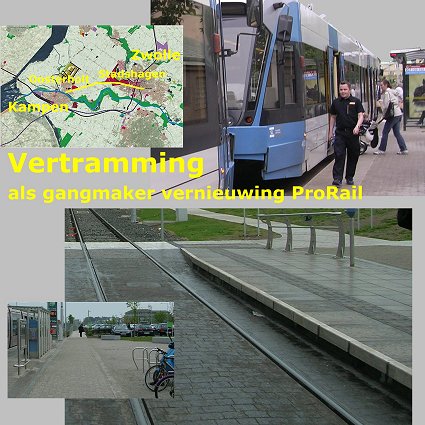
Images: (C) Lightrail.nl/Rob van der Bijl, 2006
After RandstadRail a new TramTrain in The Netherlands: according to
the awarded proposal of Rob van der Bijl (LRA) et al. - and already
announced at the pages of LRA several years ago (2003).
The regional 13km railway in the province of Overijssel between Zwolle
and Kampen will be transformed into tramway. 2015 this 'conversion type'
project is due to open.
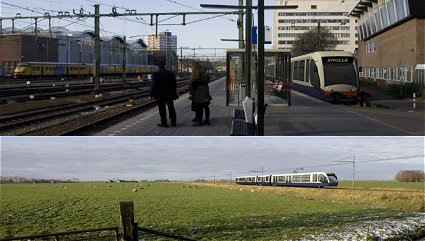
Images:
(C) Light Rail Atlas/ProRail et al., January 2009
The
tram is justified by the fact that it offers better accessibility to
existing and new urban areas. Five new stops have been envisaged.
1500 kilometers new tramway in France
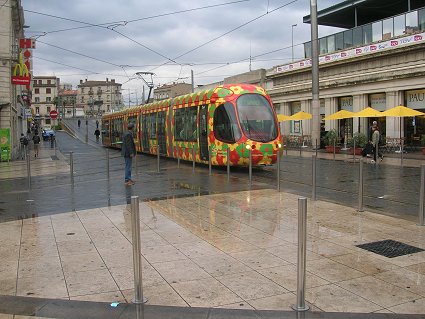
Photo:
(C) Light Rail Atlas/Rob van der Bijl, Montpellier, October 26, 2007
Line 2 is a huge success. Extension into the region of Montpellier
is envisaged.
Jean-Louis Borloo, the French minister of environment (2007) anounced
the construction of 1500km new tramways before 2020.
RandstadRail: what went wrong?
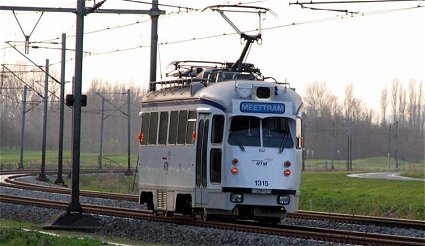
Photo:
(C) Light Rail Atlas/Kees Pronk
The track monitoring car ('Meettram'), a modified PCC, is the
only tram that is allowed on all tracks of the Den Haag (The Hague)
network. It is seen near Zoetermeer, December 6, 2006.
November
2007: RandstadRail in The Netherlands in service (first stage)! Nevertheless...
Things have gone terribly wrong. Rob van der Bijl explains. Download
his article published in 'TRAMWAYS & URBAN TRANSIT' here...
Tramway
Nijmegen (NL) considered
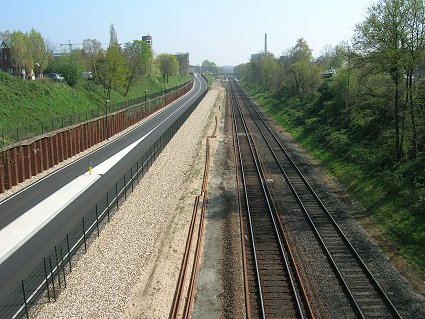
Photo:
(C) Light Rail Atlas/Rob van der Bijl, Nijmegen, April 12, 2007
The tramway will use the alignment of a busway along a regional railway.
Netherlands,
June 2007: The region of Arnhem-Nijmegen and the city of Nijmegen have
been investigating the opportunities of a tramway serving a huge medical
and university complex at the south side of town. The tramway would
serve as a shuttle between this complex and the main station, as well
as the city centre. In the future this starter line could be extended
into the region.
Three new TramTrain conversion style projects
in 2006
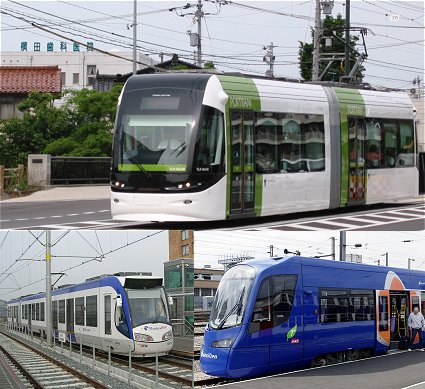
Image: Lightrail.nl, 2006
Top: Toyama "Portram" at the new street section north of Toyama
station. Left: Alstom Citadis of HTM at Zoetermeer's centre. Right:
Siemens TramTrain-vehicle of SNCF in Paris 'banlieu'.
The year 2006 witnessed the opening of three new, conversion style TT-systems.
In Japan "Portram" opened for service in April. This tram-train
uses the converted port railway of Toyama and is operated by Japan Railway
Group. Soon the line will be connected to the existing city tram network.
In Holland the first stages of "RandstadRail" were opened
in October and November. The city tram network of The Hague is extended
to Zoetermeer by tram-train using the former railway. This service is
operated by HTM. A special feature of this project is a shared track
section, used by tram-train of The Hague and the new "RandstadRail"
light rail/metro service, operated by RET, on the former railway between
Rotterdam-Hofplein and The Hague Central Station.
In France "T4" opened for service in November between Aulnay-sous-Bois
and Bondy in the 'banlieus' of Paris. This first full French tram-train
is operated by SNCF using a converted railway. All other tramways in
Paris (T1 and 2, as well as the brand new T3) are operated by RATP.
Portland streetcar extended
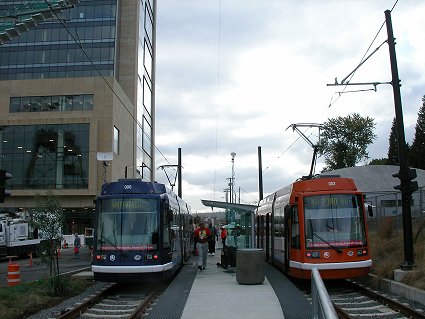
Photo: (C) Light Rail Atlas/Martin Glastra van Loon
Portland (OR), October 20, 2006
After the RiverPlace 0.6 mile extension (March 2005) the trams of Portland
(Oregon) were extended along the Willamette Riverfront to SW Gibbs Street
in the new South Waterfront neighborhood. Opening of the new 0.6 mile
section took place at the 20th of October.
August 17th of August 2007 the streetcar expanded service again, and
now terminates at South Waterfront. Transit investments such as the
streetcar and light rail are "a critical piece in our battle against
global warming", Gov. Ted Kulongoski said.
Amsterdam Line 26 successful
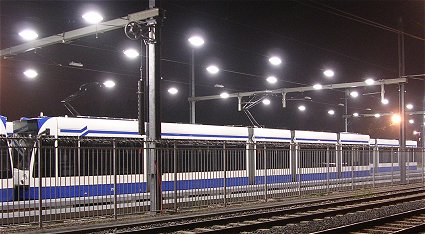
Open air depot. Photo: (C) Light Rail Atlas/Rob van der
Bijl, Amsterdam, October 15, 2005
The 30th of May 2005 was the first day of operation of Amsterdam's latest
tramway. Line 26, an almost independent new tramway system, serves a
large, new residential area built on artificial islands in the eastern
part of the Amsterdam region.
Late 2011 patronage was again higher than expected.
More Amsterdam: www.lightrail.nl/NL
Even more : www.lightrail.nl/TOD
High quality public transport in medium sized city regions
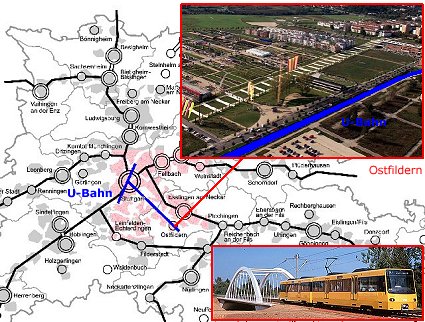
Stuttgart: one of HiTrans'case studies (HiTrans/Rob van
der Bijl, 2005) - Regional planning of the greater Stuttgart area aims
on new focal points of urban growth. Third-level-regional node Ostfildern
is an example for new transport U-Bahn infrastructure being built to
serve a huge development area. The Ostfildern site is connected to central
Stuttgart by means of two light rail lines (in blue on the map).
HiTrans
is an international project focusing on high quality public transport
in medium sized city regions (pop. 100.000-500.000). The project commenced
October 2002 and will finish September 2005. Rogaland County Council
(South Western part of Norway) is leading the project which has partners
from Norway, Sweden, Denmark, England and Scotland. The project is a
part of the Interreg IIIB, North Sea, programme, and is funded 50% by
the EU regional development funds, and 50% by the partners of the project.
Most
research is concerned with public transport in really large metropoles,
but their solutions do not necessarily suit the smaller cities. The
HiTrans project made clear that medium sized cities can achieve high
quality public transport. Public transport should be seen in relation
to other factors such as land use and urban design. Making better use
of existing rail infrastructure has beens a central topic of HiTrans;
this includes light rail, TramTrain, TrainTram and other state-of-the-art
technologies. Although rail-technology is a central topic, the project
also recognised the important role buses play in any medium sized city.
Information and documents: click here...
Back
to the top of this pages.
All
photos and texts: (C) RVDB, Amsterdam, NETHERLANDS, 1997-2012
|
|
More
highlights

The yearly national light rail conference in The Netherlands, chaired
by Rob van der Bijl (LRA). More information click here...
Or surf
to Lightrail.nl...
|




















